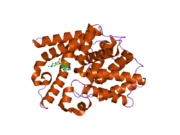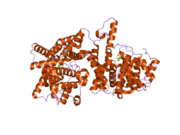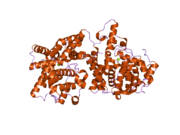PDE10A
| PDE10A | |||||||||||||||||||||||||||||||||||||||||||||||||||
|---|---|---|---|---|---|---|---|---|---|---|---|---|---|---|---|---|---|---|---|---|---|---|---|---|---|---|---|---|---|---|---|---|---|---|---|---|---|---|---|---|---|---|---|---|---|---|---|---|---|---|---|
 | |||||||||||||||||||||||||||||||||||||||||||||||||||
| |||||||||||||||||||||||||||||||||||||||||||||||||||
| Identifiers | |||||||||||||||||||||||||||||||||||||||||||||||||||
| Aliases | PDE10A, HSPDE10A19, ADSD2, IOLOD, phosphodiesterase 10A, LINC00473 | ||||||||||||||||||||||||||||||||||||||||||||||||||
| External IDs | OMIM: 610652; MGI: 1345143; HomoloGene: 4852; GeneCards: PDE10A; OMA:PDE10A - orthologs | ||||||||||||||||||||||||||||||||||||||||||||||||||
| |||||||||||||||||||||||||||||||||||||||||||||||||||
| |||||||||||||||||||||||||||||||||||||||||||||||||||
| |||||||||||||||||||||||||||||||||||||||||||||||||||
| |||||||||||||||||||||||||||||||||||||||||||||||||||
| |||||||||||||||||||||||||||||||||||||||||||||||||||
| Wikidata | |||||||||||||||||||||||||||||||||||||||||||||||||||
| |||||||||||||||||||||||||||||||||||||||||||||||||||
cAMP and cAMP-inhibited cGMP 3',5'-cyclic phosphodiesterase 10A is an enzyme that in humans is encoded by the PDE10A gene.[5][6]
Various cellular responses are regulated by the second messengers cAMP and cGMP. Phosphodiesterases, such as PDE10A, eliminate cAMP- and cGMP-mediated intracellular signaling by hydrolyzing the cyclic nucleotide to the corresponding nucleoside 5-prime monophosphate.[6][7]
Inhibitors

- Compound 96: IC50 = 700 pM, high selectivity against all other members of the PDE family[8]
- Papaverine[9]
- PF-2545920[10]
- TAK-063: IC50 = 300 pM[11]
- AMG 579[12]
- CPL500036[13]
Research
Preliminary evidence indicates a possible link between PDE10A expression and obesity in mice and humans.[14] PDE10A is a regulatory protein involved in the signaling of the striatum, a region of the brain important for controlling movement and cognition. Dysfunction of the striatum has been linked to the development of schizophrenia. Inhibition of PDE10A has been identified as a potential treatment for the disorder, and an inhibitor compound (MK-8189) is as of February 2023 in Phase 2b clinical development for the treatment of schizophrenia.[15]
References
- ^ a b c GRCh38: Ensembl release 89: ENSG00000112541 – Ensembl, May 2017
- ^ a b c GRCm38: Ensembl release 89: ENSMUSG00000023868 – Ensembl, May 2017
- ^ "Human PubMed Reference:". National Center for Biotechnology Information, U.S. National Library of Medicine.
- ^ "Mouse PubMed Reference:". National Center for Biotechnology Information, U.S. National Library of Medicine.
- ^ Fujishige K, Kotera J, Michibata H, Yuasa K, Takebayashi S, Okumura K, Omori K (June 1999). "Cloning and characterization of a novel human phosphodiesterase that hydrolyzes both cAMP and cGMP (PDE10A)". The Journal of Biological Chemistry. 274 (26): 18438–18445. doi:10.1074/jbc.274.26.18438. PMID 10373451.
- ^ a b "Entrez Gene: PDE10A phosphodiesterase 10A".
- ^ Fujishige K, Kotera J, Yuasa K, Omori K (October 2000). "The human phosphodiesterase PDE10A gene genomic organization and evolutionary relatedness with other PDEs containing GAF domains". European Journal of Biochemistry. 267 (19): 5943–5951. doi:10.1046/j.1432-1327.2000.01661.x. PMID 10998054.
- ^ a b Malamas MS, Ni Y, Erdei J, Stange H, Schindler R, Lankau HJ, et al. (November 2011). "Highly potent, selective, and orally active phosphodiesterase 10A inhibitors". Journal of Medicinal Chemistry. 54 (21): 7621–7638. doi:10.1021/jm2009138. PMID 21988093.
- ^ Siuciak JA, Chapin DS, Harms JF, Lebel LA, McCarthy SA, Chambers L, et al. (August 2006). "Inhibition of the striatum-enriched phosphodiesterase PDE10A: a novel approach to the treatment of psychosis". Neuropharmacology. 51 (2): 386–396. doi:10.1016/j.neuropharm.2006.04.013. PMID 16780899. S2CID 13447370.
- ^ Verhoest PR, Chapin DS, Corman M, Fonseca K, Harms JF, Hou X, et al. (August 2009). "Discovery of a novel class of phosphodiesterase 10A inhibitors and identification of clinical candidate 2-[4-(1-methyl-4-pyridin-4-yl-1H-pyrazol-3-yl)-phenoxymethyl]-quinoline (PF-2545920) for the treatment of schizophrenia". Journal of Medicinal Chemistry. 52 (16): 5188–5196. doi:10.1021/jm900521k. PMID 19630403.
- ^ Kunitomo J, Yoshikawa M, Fushimi M, Kawada A, Quinn JF, Oki H, et al. (November 2014). "Discovery of 1-[2-fluoro-4-(1H-pyrazol-1-yl)phenyl]-5-methoxy-3-(1-phenyl-1H-pyrazol-5-yl)pyridazin-4(1H)-one (TAK-063), a highly potent, selective, and orally active phosphodiesterase 10A (PDE10A) inhibitor". Journal of Medicinal Chemistry. 57 (22): 9627–9643. doi:10.1021/jm5013648. PMID 25384088.
- ^ Hu E, Chen N, Bourbeau MP, Harrington PE, Biswas K, Kunz RK, et al. (August 2014). "Discovery of clinical candidate 1-(4-(3-(4-(1H-benzo[d]imidazole-2-carbonyl)phenoxy)pyrazin-2-yl)piperidin-1-yl)ethanone (AMG 579), a potent, selective, and efficacious inhibitor of phosphodiesterase 10A (PDE10A)". Journal of Medicinal Chemistry. 57 (15): 6632–6641. doi:10.1021/jm500713j. PMID 25062128.
- ^ Matloka M, Janowska S, Pankiewicz P, Kokhanovska S, Kos T, Hołuj M, et al. (2022). "A PDE10A inhibitor CPL500036 is a novel agent modulating striatal function devoid of most neuroleptic side-effects". Frontiers in Pharmacology. 13: 999685. doi:10.3389/fphar.2022.999685. PMC 9681820. PMID 36438799.
- ^ Hankir MK, Kranz M, Gnad T, Weiner J, Wagner S, Deuther-Conrad W, et al. (July 2016). "A novel thermoregulatory role for PDE10A in mouse and human adipocytes". EMBO Molecular Medicine. 8 (7): 796–812. doi:10.15252/emmm.201506085. PMC 4931292. PMID 27247380.
- ^ Layton ME, Kern JC, Hartingh TJ, Shipe WD, Raheem I, Kandebo M, et al. (January 2023). "Discovery of MK-8189, a Highly Potent and Selective PDE10A Inhibitor for the Treatment of Schizophrenia". Journal of Medicinal Chemistry. 66 (2): 1157–1171. doi:10.1021/acs.jmedchem.2c01521. PMC 9884086. PMID 36624931.
Further reading
- Loughney K, Snyder PB, Uher L, Rosman GJ, Ferguson K, Florio VA (June 1999). "Isolation and characterization of PDE10A, a novel human 3', 5'-cyclic nucleotide phosphodiesterase". Gene. 234 (1): 109–117. doi:10.1016/S0378-1119(99)00171-7. PMID 10393245.
- Kotera J, Fujishige K, Yuasa K, Omori K (August 1999). "Characterization and phosphorylation of PDE10A2, a novel alternative splice variant of human phosphodiesterase that hydrolyzes cAMP and cGMP". Biochemical and Biophysical Research Communications. 261 (3): 551–557. doi:10.1006/bbrc.1999.1013. PMID 10441464.
- Zauli G, Milani D, Mirandola P, Mazzoni M, Secchiero P, Miscia S, Capitani S (February 2001). "HIV-1 Tat protein down-regulates CREB transcription factor expression in PC12 neuronal cells through a phosphatidylinositol 3-kinase/AKT/cyclic nucleoside phosphodiesterase pathway". FASEB Journal. 15 (2): 483–491. doi:10.1096/fj.00-0354com. PMID 11156964. S2CID 26315564.
- Frame M, Wan KF, Tate R, Vandenabeele P, Pyne NJ (October 2001). "The gamma subunit of the rod photoreceptor cGMP phosphodiesterase can modulate the proteolysis of two cGMP binding cGMP-specific phosphodiesterases (PDE6 and PDE5) by caspase-3". Cellular Signalling. 13 (10): 735–741. doi:10.1016/S0898-6568(01)00193-0. PMID 11602184.
- Gross-Langenhoff M, Hofbauer K, Weber J, Schultz A, Schultz JE (February 2006). "cAMP is a ligand for the tandem GAF domain of human phosphodiesterase 10 and cGMP for the tandem GAF domain of phosphodiesterase 11". The Journal of Biological Chemistry. 281 (5): 2841–2846. doi:10.1074/jbc.M511468200. PMID 16330539.
- Chappie TA, Helal CJ, Hou X (September 2012). "Current landscape of phosphodiesterase 10A (PDE10A) inhibition". Journal of Medicinal Chemistry. 55 (17): 7299–7331. doi:10.1021/jm3004976. PMID 22834877.
This article incorporates text from the United States National Library of Medicine, which is in the public domain.
- v
- t
- e
-
 2o8h: Crystal structure of the catalytic domain of rat phosphodiesterase 10A
2o8h: Crystal structure of the catalytic domain of rat phosphodiesterase 10A -
 2oun: crystal structure of PDE10A2 in complex with AMP
2oun: crystal structure of PDE10A2 in complex with AMP -
 2oup: crystal structure of PDE10A
2oup: crystal structure of PDE10A -
 2ouq: crystal structure of PDE10A2 in complex with GMP
2ouq: crystal structure of PDE10A2 in complex with GMP -
 2our: crystal structure of PDE10A2 mutant D674A in complex with cAMP
2our: crystal structure of PDE10A2 mutant D674A in complex with cAMP -
 2ous: crystal structure of PDE10A2 mutant D674A
2ous: crystal structure of PDE10A2 mutant D674A -
 2ouu: crystal structure of PDE10A2 mutant D674A in complex with cGMP
2ouu: crystal structure of PDE10A2 mutant D674A in complex with cGMP -
 2ouv: crystal structure of pde10a2 mutant of D564N
2ouv: crystal structure of pde10a2 mutant of D564N -
 2ouy: crystal structure of pde10a2 mutant D564A in complex with cAMP.
2ouy: crystal structure of pde10a2 mutant D564A in complex with cAMP. -
 2ovv: Crystal structure of the catalytic domain of rat phosphodiesterase 10A
2ovv: Crystal structure of the catalytic domain of rat phosphodiesterase 10A -
 2ovy: Crystal structure of the catalytic domain of rat phosphodiesterase 10A
2ovy: Crystal structure of the catalytic domain of rat phosphodiesterase 10A
 | This article on a gene on human chromosome 6 is a stub. You can help Wikipedia by expanding it. |
- v
- t
- e
































